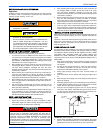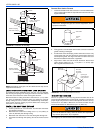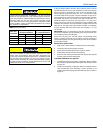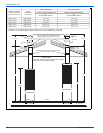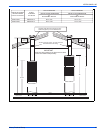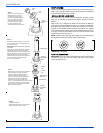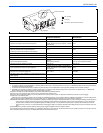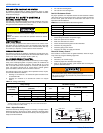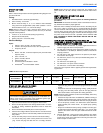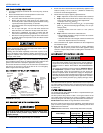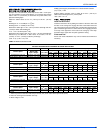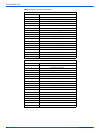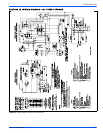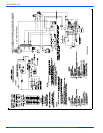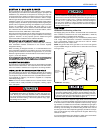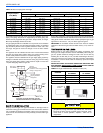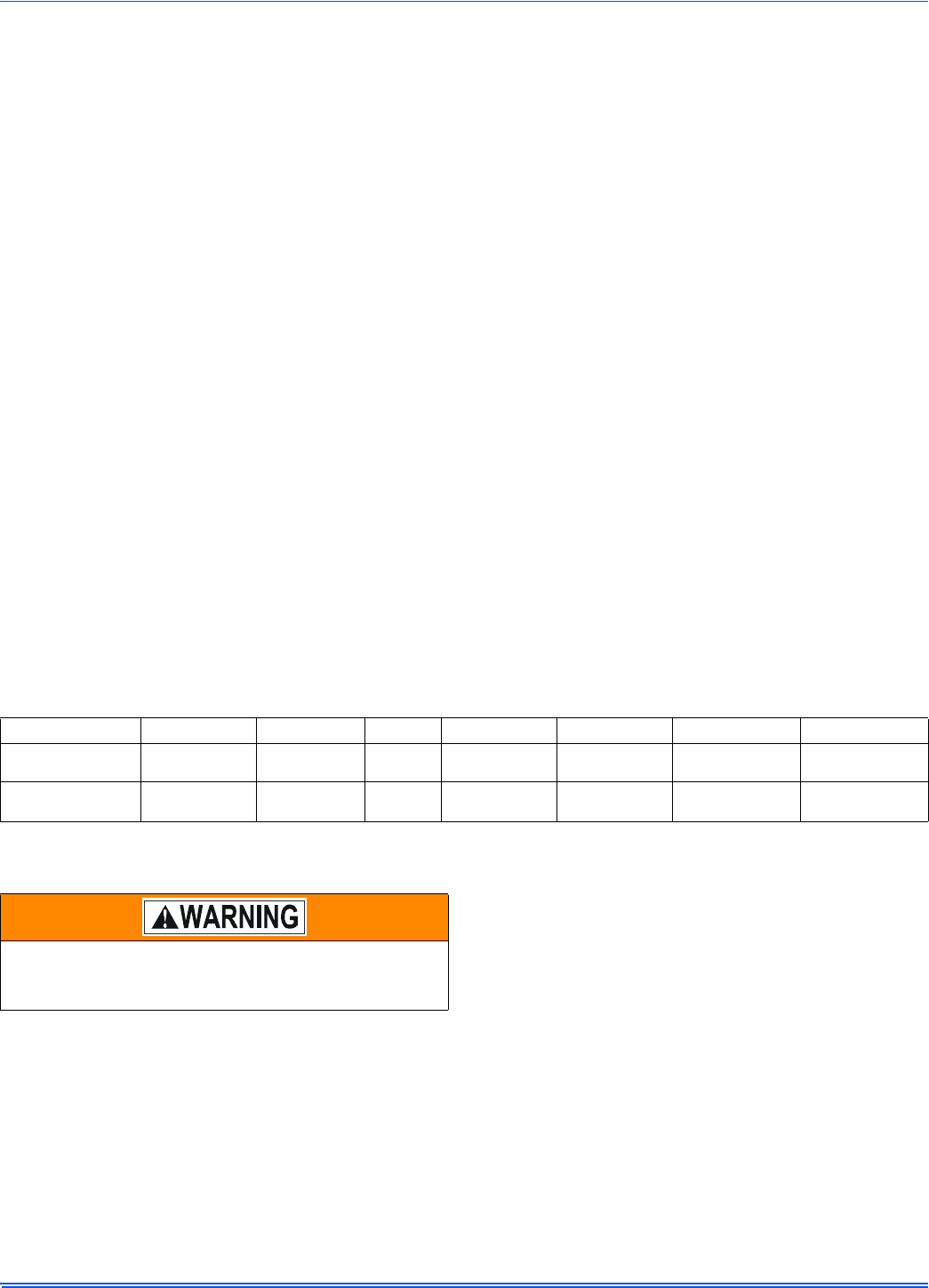
107272-UIM-B-1105
Unitary Products Group 23
SPECIFICATIONS
Models:
Table 11 lists the major features and the applicable wiring diagram num-
bers for the R7184.
Timing:
1. Safe Start Check: 5 seconds (approximately)
2. Valve-on Delay: 15 seconds.
3. Burner motor-off Delay: 0, 2, 4, or 6 minutes. Field selectable
using dual in-line programmable (DIP) switch positions 1 and 2.
Select models have 0.5, 2, 4, or 8 minute delays.
NOTE: Valve-on delay and burner motor-off delay timings can be
enabled (values as listed) or disabled (values are zero) in the field,
using DIP switch position 3.
4. Lockout: 15, 30, or 45 seconds (factory-programmed).
5. Recycle: 60 seconds (fixed).
6. Ignition Carryover: 10 seconds (fixed).
Electrical Ratings:
Inputs:
a. Voltage: 102 to 132 VAC, 120 VAC nominal.
b. Current: 100 mA plus burner motor, valve and igniter loads.
c. Frequency: 60 Hz.
Outputs:
a. Burner: 120 VAC, 10 full load amperes (FLA), 60 locked rotor
amperes (LRA).
b. Valve: 120 VAC, 1A
c. Igniter: 120 VAC, 360 VA
d. Alarm: 30 VAC, 2A
e. Thermostat Current Available: 100mA
F. E nvi raCOM
TM
Current Available: 150mA
NOTE: Reduce burner FLA rating by igniter load. For example, if the
igniter draws 3A (120 VAC, 360 VA), reduce the burner motor FLA to
7A.
SECTION VIII: START-UP AND
ADJUSTMENTS
The initial start-up of the furnace requires the following additional
procedures:
IMPORTANT: All electrical connections made in the field and in the fac-
tory should be checked for proper tightness.
When the oil line is initially connected to the furnace, the tubing may be
full of air. In order to purge this air, it is recommended that the bleed
valve be loosened until no air bubbles are detected in the plastic tubing.
If burner does not light, press the reset button on the primary control
once only and bleed oil pump again. If burner still does not light, turn off
the power to the furnace and call a qualified service technician. DO
NOT CONTINUE TO PRESS THE RESET BUTTON ON THE PRI-
MARY CONTROL.
TOOLS AND INFORMATION THAT WILL BE
REQUIRED IN ORDER TO PROPERLY PERFORM THE
FURNACE STARTUP PROCEDURE.
1. You will need a thermometer or portable digital thermometer to
read the supply and return air temperatures.
2. You will need a pressure gauge that has the ability to read pres-
sures between 0 - 100 PSIG (0 - 689 kPa) in order to measure the
oil pump pressures.
3. You will need a 3/32” Allen wrench for the pressure port adjust-
ment screw in the oil pump.
4. You will need 1 piece of 1/4” (0.63 cm) ID flexible tubing that is 12”
(30 cm) in length
5. You will need a clear plastic jug.
6. You will need a 7/16” open end or box wrench.
7. You will need a 1/4” brass NPT x flare fitting.
These items are required in order to properly perform the required start-
up procedure.
START-UP AND ADJUST BURNER
Start-up Burner / Set Combustion
1. Open the shut-off valves in the oil supply line to the burner.
2. Set the air boot adjustment to the setting stated in Table 12. This is
an initial air setting. Additional adjustments must be made with
instruments.
3. Set the thermostat substantially above room temperature.
4. Close the line voltage switch to start the burner. If the burner does
not start, you may have to reset the safety switch of the burner pri-
mary control.
5. Vent air from fuel pump as soon as burner motor starts rotating.
• To vent the fuel pump, attach a clear plastic hose over the vent
plug. Loosen the plug and catch the oil in an empty container.
Tighten the plug when all air has been purged from the oil supply
system.
• If the burner locks out on safety during venting, quickly close the
vent plug, reset the safety switch, open the vent plug when the
motor starts rotation, and complete the venting procedure.
NOTE: Electronic safety switches can be reset immediately; others may
require a 3 to 5 minute wait.
• If the burner stops after flame is established, additional venting is
probably required. Repeat the venting procedure until the pump
is primed and a flame is established when the vent plug is closed.
• For R7184 primary controls, see Technician’s Quick Reference
Guide, Beckett part number 61351, for special pump priming
sequence.
• Prepare for combustion tests by taking a sample in the flue pipe.
A combustion sample should be taken with a 1/4” (0.4 km) tube
placed in the center of the vent pipe outside beneath the crown
assembly.
6. Initial air adjustment - Using a smoke tester, adjust the air to obtain
a clean flame. Now the additional combustion tests with instru-
ments can be made. Never drill a hole in the roof jack to take com-
bustion sample or smoke tests.
TABLE 12:
Burner Specifications
Furnace Model Burner Spec ATC Head Static Plate Nozzle Pump Pressure Air Boot Setting
DFAA084BBTA
DFAH084BBSA
EVC - 201 AF36YHHS F3 3 - 3/8 U
0.65 x 70° A
Delavan
100 psi (689 kPa) 4.0
DFAA066BBTA
DFAH066BBSA
EVC - 202 AF36YHHS F3 3 - 3/8 U
0.50 x 70° A
Delavan
100 psi (689 kPa) 3.0
Do not attempt to start the burner when excess fuel or vapor has
accumulated in the appliance. Starting the burner under these con-
ditions could result in a puff back of hot combustion gases, high
smoke levels, or otherwise hazardous operation.



